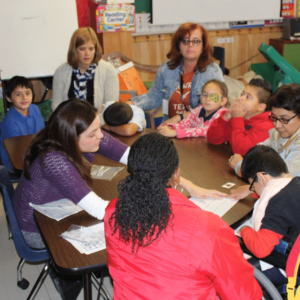Making Life Better in the Schools : A How-to Course on Service Delivery Models
$15.00

Course Type: Video – 1 hour
ASHA Course Code: Service Delivery Associated with Speech, Language, Hearing and Related Disorders – 7010
You can improve how you support your teachers and reduce therapy planning time!
The ASHA Schools Survey (2014) reports that caseloads over the last several years have remained the same with a median caseload size of 47. However, the responsibilities of school-based SLPs have changed greatly. This course provides speech-language pathologists with tools to increase their effectiveness in the schools and decrease overall workload. An understanding of various service delivery models can potentially increase students’ communicative success, improve relationships within educational teams and increase SLP job satisfaction.
Additional Information
| Population | School Age |
|---|---|
| Topics | SLP Professional |
| Duration | 1 hour |
| Credit | .1 Continuing Education Unit |
| Format | Video |
Financial Disclosure: Phuong Lien Palafox, M.S., CCC-SLP was an employee of Bilinguistics. Bilinguistics receives royalty payments for online courses.
Non-Financial Disclosure: Phuong Lien Palafox does not have any non-financial relationships to disclose.
The ASHA Schools Survey 2014 reports that caseloads over the last several years have remained the same with a median caseload size of 47. However, the responsibilities of school-based SLPs have changed greatly. Factors impacting workload include caseload, student factors (e.g., severity of disability) and IDEA mandates (e.g., Least Restrictive Environment, Alignment to Curriculum). Approximately 80% of school-based speech-language pathologists, per the 2014 ASHA Schools Survey, report increased workload as the reason for the shortage of professionals in the field. With the increasing demand, SLPs are searching for ways in which to provide effective services within an approximate 40-hour work week.
At this time, approximately 80% of students served in the schools are pulled out of the classroom to receive speech-language therapy. And, most of these students receive 30 minutes twice a week of speech-language therapy. Essentially, speech-language pathologists have approximately 30 contacts hours with students during a school year. General education teachers, on the other hand, have access to students for 28% of their waking hours. This is equivalent to 1,260 hours annually. In turn, we need to build capacity by supporting teachers and increasing their knowledge base of speech-language strategies to make a lasting effect for students. Use of various service delivery models is one way in which to increase generalization of students’ communication skills, support teachers and support the goals of IDEA mandates while maintaining a manageable workload for school-based speech-language pathologists.
At this time, overall there is little evidence on which to base decisions about service delivery options (Cirrin, 2010). A study conducted by Throneberg (2010) demonstrated a clear advantage for classroom-based team teaching to improve students’ curricular vocabulary knowledge. Miginty and Justice (2006) reviewed three studies (Throneburg et al., 2000; Valdez & Montgomery, 1997; Wilcox, Kouri, & Caswell, 1991) and concluded that classroom-based interventions, when compared to individual and group pull-out, support vocabulary growth. In general, however, there are few studies addressing service delivery models. The studies that currently exist do not meet the inclusion criteria for an evidenced-based systematic review. In turn, it is important to explore the effectiveness of classroom-based and collaborative service delivery models for children with speech and language needs.
Participants will:
Identify information and effectiveness related to current service delivery trends.
Identify research and benefits of various speech and language service delivery models.
List steps for implementing an intensive, 3 to 1 and co-teaching service delivery models.
Time-Ordered Agenda:
05 minutes: Introduction
15 minutes: Review of Speech Pathologist expected work performance in comparison to average caseload and job satisfaction ratings
10 minutes: Introduction of ASHA school surveys data and caseload data
05 minutes: Presentation of single-case study methods
10 minutes: Presentation of results of changes to the service delivery model
20 minutes: Demonstration of how to achieve similar results
10 minutes: Introduction of helpful materials
05 minutes: Course quiz and evaluation
Need CEUs?

 Share
Share
 Tweet
Tweet
 LinkedIn
LinkedIn
 Pin
Pin
 Email
Email




